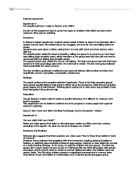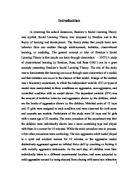Throughout his study, Triplett observed the performances of bike racers while watching a race. He noticed that the participants in the race showed a better performance and faster times when racing with others instead of just racing alone. He then concluded that the presence of competitors contributed to this major change of outcome in the bike riders’ race. This observation sparked Triplett’s interest into furthering the study of social facilitation. Triplett also conducted a study that had school-age children turn a fishing reel as fast as possible for a short period of time, leading him to find that when the children worked in pairs their performance was superior to that when they worked alone. The theory of social facilitation has since had a major impact in the world of psychology
In my replication of Triplett’s experiment, I judged the presence of social facilitation when people were running a certain distance. I timed each person once when running alone and another time when running together with a group. Comparing the speeds, I hoped to determine if the people tested perform better in groups compared to being alone. The independent variable in my experiment was the number of people racing, and the dependent variable was the speed/time.
Method
Design:
In my experiment, I used repeated measures as my data to help me come to my conclusion. This was my experiment design, controlling specific internal validity concerns throughout the procedure. For the selection of my participants, I had a 15 people choose a group number out of a hat, to determine the group number they would be tested with, and they were separated into three random groups to make the testing easier and more efficient. All of the people participating had the choice of participating or not, therefore participants were more willing to cooperate if they volunteered. I expected to have a very low mortality rate, if there was one at all. The experiment was very fast, easy, and effortless for the participants, contributing to each participant’s choice to continue to be involved in the procedure. As I stated before, each partaker already agreed to help and hopefully felt the obligation to carry on their commitment. I was very ethical in this experiment. I informed all involved of the procedure and all that would be asked from them. To keep results accurate, I did not inform them of the meaning of social facilitation, the main topic of my state, because I did not want it to affect the outcome. The subjects were given the opportunity to quit whenever they wanted and I made it as easy for them as possible. Hopefully, my ethical take on this study added to making my results more exact. Dealing with maturation factors, all of the subjects were studied at the same time and the same place, making sure no others factors would contribute to the differences in the experiment. I was sure to inform all members of the study that they must listen and use our time effectively. I strictly encouraged no messing around and stressed the importance of their focus during the process. To eliminate experimental bias in the study, I was not the only person testing these subjects. I had a couple of friends who were not participating in the study help me to time each participant’s running times to make the results more accurate.
Materials:
In performing the experiment, the only instruments needed were a five stop watches, brand new and precise, and pencil and paper with a previously configured chart. This made the instrumentation concerns very slim because I depended only on one major instrument as a source of information. As there were many concerns in this study, I hope that I did my best to eliminate as many as possible.
Participants:
My target population was an opportunity sample. The participants of my study were chosen from a group of youth at my church. My youth group, ages twelve to seventeen, volunteered to partake in this testing. With most of them being active, it means they were mostly on the same athletic level, helping the calculations to be more precise. The group was chosen randomly and I only had fifteen people actually participating, making it easier to test all of them accurately.
Procedure:
My procedure was fairly easy and not too extensive. First, all participating subjects picked a random group number out of a hat, numbers one through five. They were then separated into different groups which only determined the order in which they would be tested. Group one went first as I timed their speed over a distance of ten yards, each at a different time, running alone. Once all group one subjects had been timed, I tested them each when running with the entire group over the same distance. I used the help of other people to make sure I timed them each accurately. This process was repeated for groups two, three, four and five also. All results were written in my chart to help me to determine the validity of my previously formed hypothesis.
Results
Level of Measurement:
For my social facilitation experiment, I collected ordinal data. My data was ordinal because it can be ranked. I made charts that showed the times of each person tested when they ran the given distance alone and when they ran with a group. Making a chart was the easiest way of recording my data throughout the entire experiment. This chart helped me to be able to compare each person and their fastest time. I concluded that social facilitation was consequently accurate in my experiment.
Descriptive Statistics:
In total, out of the fifteen people studied and timed for both situations of running, thirteen people showed a better performance when running against others rather than just running on their own. This showed that 86.667% of the time, my hypothesis was correct in my study. Although in most cases, the increase in speed was a very slight change, but it was still a large enough change that it was noticed.
Average times…
This section includes numerical and graphical reporting of the data collected by the candidate. The results must be stated in narrative form and in graphical form. The data should be reported in a away that reflects the claims made in the aims and hypothesis.
Graphs and tables may be drawn on the computer. One graph is usually sufficient. Computers can create many different graphs, but candidates should be advised against producing irrelevant graphs. Candidates must not include graphs that show each individual participant's score.
Discussion
In Triplett’s study of social facilitation, his results showed that the bikers he tested performed better in a group than when they were alone. My results were extremely similar to his. I found that when I tested the speeds of people running alone, they were slower than when testing the same people when put into a group. I predicted this in my hypothesis and therefore my experiment showed my predictions to be accurate in this case study.
Like all experiments, my experiment included a few strengths and weaknesses. I tried very hard to be ethical throughout my experiment by treating the participants with respect and informing them of the process. This helped them to be more cooperative and easy to work with. Another strength I found in my experiment was the method that I chose to collect the needed data. Instead of being the only person timing the speed of each participant, other people helped me to be as accurate as possible. This methodology proved to be successful. On the contrary, my main weakness was that I was limited on the amount of people I could test. Because this procedure could not be conducted in a classroom, I had to find another group of people that would be willing to participate. If I had been able to test a more diverse class, my results could have been more accurate.
I know that my results cannot be generalized outside of the opportunity sample because it is a non-representative sample, but I do believe that I came to the right conclusion. If I could do this experiment again, I would have tested the same groups more than once, on different days so that certain factors such as tiredness or hunger of the participants would not contribute to the results.
In conclusion, according to the results of my replication of Triplett’s experiment based on social facilitation, people perform better in groups compared to being alone.
References
Appleby, Karen M. "Sport Psychology: History, Professional Organizations & Professional Preparation - Psi Chi." Psi Chi, the National Honor Society in Psychology. Dec. & jan. 2009 <http://www.psichi.org/pubs/articles/article_646.asp>.
"Social Facilitation." Samiam.colorado.edu. Dec. & jan. 2009 <http://samiam.colorado.edu/~mcclella/expersim/introsocial.html>.
"The American Journal of Psychology." VCU College of Humanities & Sciences. Dec. & jan. 2009 <http://www.has.vcu.edu/group/trip.htm>.
Appendix
Chart of Progress:
Tools Needed:
- This chart
- Pencils/Pens for each person timing the speeds
- Five stop watches (one for each person timing)
- Pieces of paper with group numbers on it (Five with each number one to five) in a bag/hat







